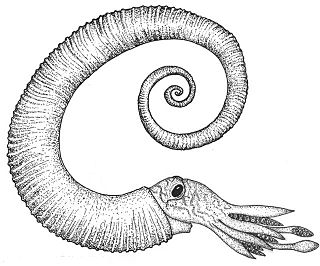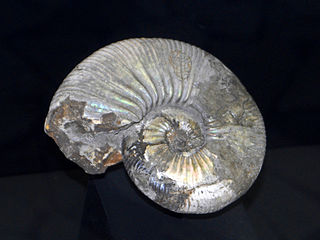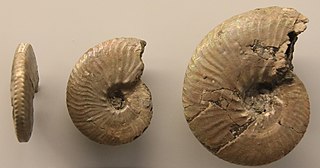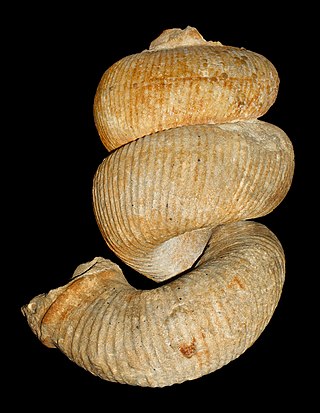
The Ancyloceratina were a diverse suborder of ammonite most closely related to the ammonites of order Lytoceratina. They evolved during the Late Jurassic but were not very common until the Cretaceous period, when they rapidly diversified and became one of the most distinctive components of Cretaceous marine faunas. They have been recorded from every continent and many are used as zonal or index fossils. The most distinctive feature of the majority of the Ancyloceratina is the tendency for most of them to have shells that are not regular spirals like most other ammonites. These irregularly-coiled ammonites are called heteromorph ammonites, in contrast to regularly coiled ammonites, which are called homomorph ammonites.

Ammonitida or "True ammonites" are an order of ammonoid cephalopods that lived from the Jurassic through Paleocene time periods, commonly with intricate ammonitic sutures.

Acanthohoplites is an extinct genus of ammonites in the family Parahoplitidae that lived in the Aptian and Early Albian stages of the Early Cretaceous.

Anahoplites is a genus of rather involute, compressed hoplitid ammonites with flat sides, narrow flat or grooved venters, and flexious ribs or striae arising from weak umbilicle tubercles that end in fine dense ventrolateral nodes. The elements of their sutures are short, wide and jaggedy. Specimens of Annahoplites have diameters typically in the range of 4–6 centimetres (1.6–2.4 in) although some with diameters of as much as 19 centimetres (7.5 in) have been reported. The genus lived during the Cretaceous, from the Middle to the late Albian.
Astiericeras is an ammonite from the Lower Cretaceous, the shell of which is evolute, stout; outer whorl with strong, well spaced, transverse ribs that cross smoothly over the broad venter; early whorls with lateral tubercles. The outer, mature whorl separates from the coil but hooks back quickly, referred to as a heteromorph.
Anisoceras is a heteromorph ammonite belonging to the turrilitoid family Anisoceratidae. The shell forms a loose open helical spiral in the early stages, ending in one or two straight shafts in the mature adult. Surface ornament consists of prominent rounded nodes on the lower and upper flanks, connected by strong looped ribs. The nodes may have been the bases of long sharp spines.

Baculitidae is a family of extinct ammonoid cephalopods that lived mostly during the Late Cretaceous, and often included in the suborder Ancyloceratina.

Lytoceratina is a suborder of Jurassic and Cretaceous ammonites that produced loosely coiled, evolute and gyroconic shells in which the sutural element are said to have complex moss-like endings.

Turrilitoidea is a diverse superfamily of Cretaceous ammonites generally considered as heteromorphic and commonly included in the suborder Ancyloceratina. Shells of this diverse group do not coil planospirally, as typical for most ammonites, but rather take on a variety of unique forms. Separation of Turrilitoidea along with Ptychoceratoidea and Scaphatoidea into a different suborder, Turrilitina, was proposed by Beznosov and Mikhailova in 1983 however this view is not accepted by most authors.

Nipponites is an extinct genus of heteromorph ammonites. The shells of Nipponites form "ox-bow" bends, resulting in some of the most bizarre shapes seen among ammonites.

Bostrychoceras is a genus of heteromorph ammonite from the family Nostoceratidae. Fossils have been found in Late Cretaceous sediments in Europe and North America.

Exiteloceras is an ammonite genus from the Late Cretaceous.

Nostoceras is an extinct genus of ammonites. The etymology of the name Nostoceras comes from "nostos" meaning return and "ceros" meaning horn, named as such by Alpheus Hyatt because it bends back on itself.
Heteroceras is a genus of Lower Cretaceous heteromorph ammonites belonging to the ancyloceratoidean family, Heteroceratidae.
Ancyloceratoidea, formerly Ancylocerataceae, is a superfamily of typically uncoiled and loosely coiled heteromorph ammonoids established by Alpheus Hyatt in 1900, that may contain as many as 11 families, depending on the classification accepted.
Turrilitina is a proposed suborder of Cretaceous heteromorph ammonoid cephalopods derived from the Lytoceratidae in the Hauterivian stage of the Lower Cretaceous that would include the superfamilies Turrilitoidea, Ptychoceratoidea, and Scaphatoidea.

Ancyloceratidae is a family of heteromorphic ammonites that lived during the Early Cretaceous. Their shells begin as a loose spiral with whorls not touching which then turns into a straight shaft that ends in a J-shape hook or bend at end. Coarse ribbing and spines are common.

Spitidiscus is a genus of ammonites placed in the family Holcodiscidae.

Heinzia is an extinct ammonoid cephalopod genus belonging to the family Pulchelliidae. They lived during the Cretaceous, in the Barremian age.

Dufrenoyia is an extinct genus of Cretaceous ammonites included in the family Parahoplitidae. These fast-moving nektonic carnivores lived in the Cretaceous period. The type species of the genus is Ammonites dufrenoyi.













